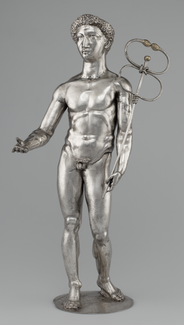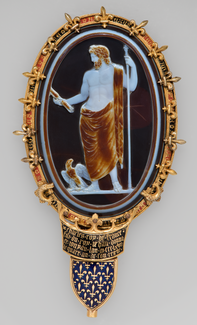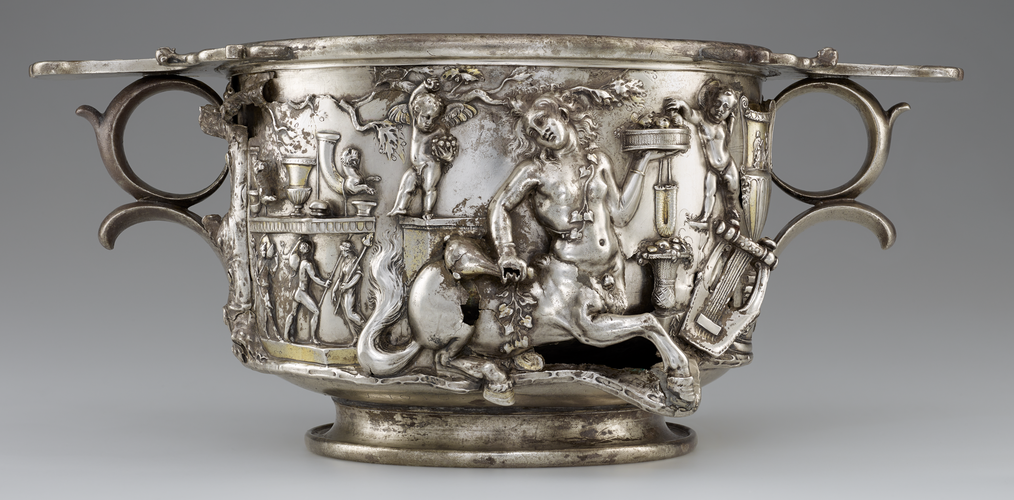Exhibitions: Devotion and Decadence
Devotion and Decadence: The Berthouville Treasure and Roman Luxury
from the Bibliothèque nationale de France
October 17, 2018 - January 6, 2019
This article first appeared in ISAW Newsletter 21 (Spring 2018).
 Statuette of Mercury. Roman, 175–225 CE. Berthouville, France. Silver and gold. Bibliothèque nationale de France, Paris: Inv. 56.1. Photo: Tahnee Cracchiola © Getty-BnF
Discovered by chance by a farmer in rural Normandy while plowing his field, the Berthouville Treasure is the largest and best-preserved hoard of silver from the ancient world. Silver statuettes and vessels— about ninety pieces weighing over fifty pounds in total—had been buried in a brick-lined cist during antiquity. Located in an area of ancient pilgrimage, assembly, and spectacle, the site was a Gallo- Roman religious sanctuary devoted to Mercury Canetonensis. The temple treasure includes extraordinary representations of Mercury as well as other pieces illustrating vivid episodes from the Trojan War and theatrical Bacchic scenes. The collection offers a striking example of the cross-cultural interactions between Roman and indigenous Gallic culture.
Statuette of Mercury. Roman, 175–225 CE. Berthouville, France. Silver and gold. Bibliothèque nationale de France, Paris: Inv. 56.1. Photo: Tahnee Cracchiola © Getty-BnF
Discovered by chance by a farmer in rural Normandy while plowing his field, the Berthouville Treasure is the largest and best-preserved hoard of silver from the ancient world. Silver statuettes and vessels— about ninety pieces weighing over fifty pounds in total—had been buried in a brick-lined cist during antiquity. Located in an area of ancient pilgrimage, assembly, and spectacle, the site was a Gallo- Roman religious sanctuary devoted to Mercury Canetonensis. The temple treasure includes extraordinary representations of Mercury as well as other pieces illustrating vivid episodes from the Trojan War and theatrical Bacchic scenes. The collection offers a striking example of the cross-cultural interactions between Roman and indigenous Gallic culture.
The farmer, Prosper Taurin, had originally intended to sell the Treasure for the value of the silver. But
 Cameo of Jupiter (The Cameo of Chartres) Set in Fourteenth-Century Mount. Roman, ca. 50 CE. Rome, mounted in Paris. Sardonyx; gold and enamel mount. Bibliothèque nationale de France, Paris: Camée.1. Photo © Bnf
instead of melting it down (as many similar discoveries were reported to have been), Taurin shared news of his good fortune with a relative who recommended that they show several pieces to an expert from the Society of Antiquaries of Normandy. This expert, Auguste Le Prévost, communicated news of the discovery to Paris and convinced Taurin that the historic significance and aesthetic qualities enhanced the value of the Treasure beyond the market price of the silver. And indeed it did: A bidding war ensued between a representative of the Musée du Louvre, Charles Lenormant, and a curator from the Bibliothèque nationale de France, Désiré Raoul-Rochette. Raoul-Rochette won by offering Taurin more than he was authorized to pay, thus securing the acquisition for the Bibliothèque nationale de France, but tarnishing his own reputation and damaging his subsequent career. His professional misstep is our benefit today.
Cameo of Jupiter (The Cameo of Chartres) Set in Fourteenth-Century Mount. Roman, ca. 50 CE. Rome, mounted in Paris. Sardonyx; gold and enamel mount. Bibliothèque nationale de France, Paris: Camée.1. Photo © Bnf
instead of melting it down (as many similar discoveries were reported to have been), Taurin shared news of his good fortune with a relative who recommended that they show several pieces to an expert from the Society of Antiquaries of Normandy. This expert, Auguste Le Prévost, communicated news of the discovery to Paris and convinced Taurin that the historic significance and aesthetic qualities enhanced the value of the Treasure beyond the market price of the silver. And indeed it did: A bidding war ensued between a representative of the Musée du Louvre, Charles Lenormant, and a curator from the Bibliothèque nationale de France, Désiré Raoul-Rochette. Raoul-Rochette won by offering Taurin more than he was authorized to pay, thus securing the acquisition for the Bibliothèque nationale de France, but tarnishing his own reputation and damaging his subsequent career. His professional misstep is our benefit today.
For its presentation at ISAW, the Berthouville Treasure will be joined by approximately seventy-five other luxury objects from the collections of the Bibliothèque nationale de France including silver platters, cameos, gems, coins, and jewelry. Such prestige objects were not only used as votive offerings to the gods, but also functioned in daily life as signs of their owner’s wealth, power, and refinement. Devotion and Decadence: The Berthouville Treasure and Roman Luxury provides an exceptional opportunity to explore the significance of Roman luxury arts and its role in different devotional and cultural settings.
 Cup with Centaurs and Cupids. Roman, 1–100 CE. Berthouville, France. Silver and gold. Bibliothèque nationale de France, Paris: Inv. 56.7. Photo: Tahnee Cracchiola © Getty-BnF
Cup with Centaurs and Cupids. Roman, 1–100 CE. Berthouville, France. Silver and gold. Bibliothèque nationale de France, Paris: Inv. 56.7. Photo: Tahnee Cracchiola © Getty-BnF